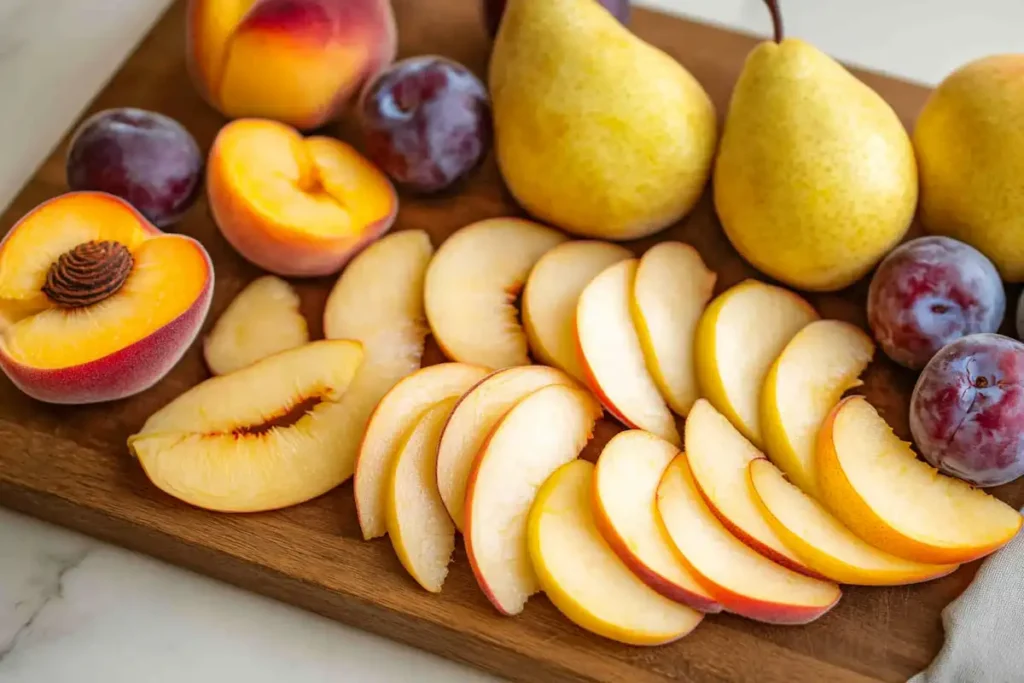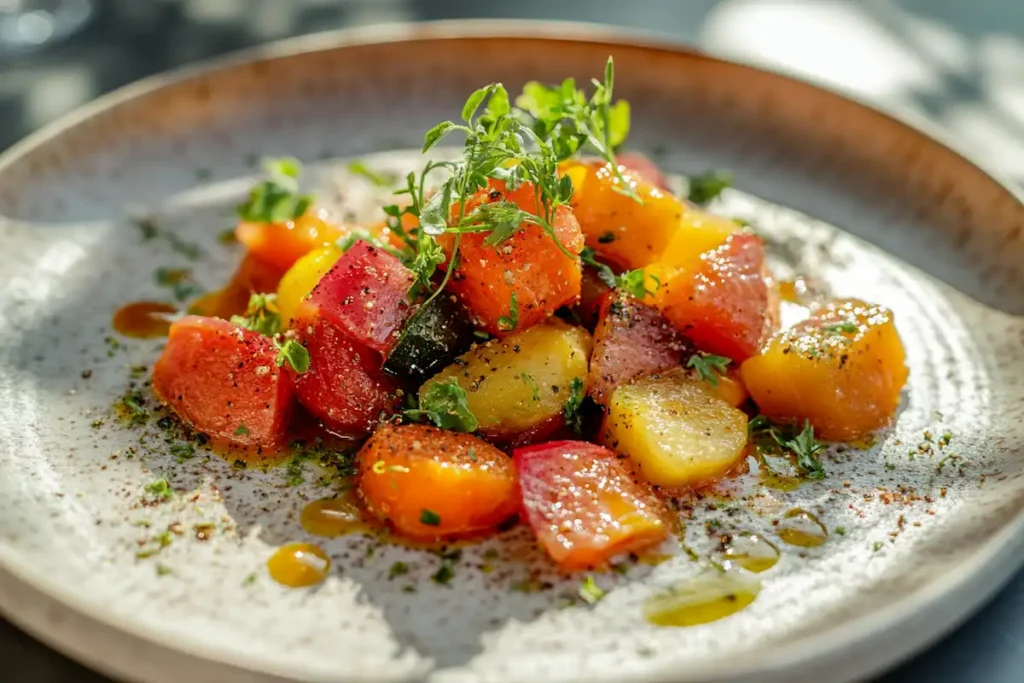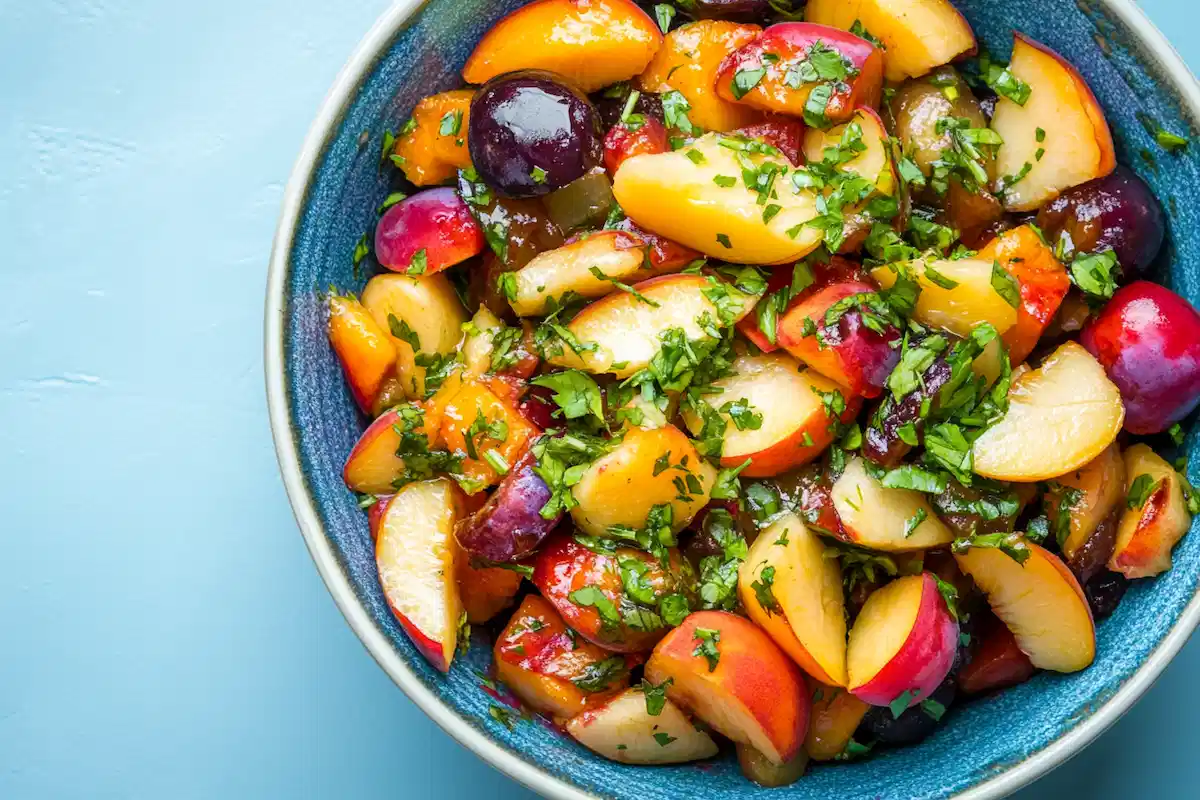Experience a vibrant ratatouille fruit version featuring fresh produce and sweet flavors. This unique spin revitalizes a classic dish.
Introduction
Ratatouille is traditionally known as a comforting French stew made with eggplant, zucchini, tomatoes, and other garden-fresh vegetables. However, the culinary world is continually evolving, and creative chefs are always testing new ways to keep classic dishes exciting. One fascinating reinvention is the ratatouille fruit version, a sweet and savory twist that shines a bright spotlight on seasonal produce. This version plays with flavor and texture in unexpected ways, blending sweetness with subtle herbal undertones. Therefore, if you are looking to explore something innovative or simply want to serve a standout dish at your next gathering, this article will guide you through the steps of making a scrumptious ratatouille fruit version that appeals to all palates.
In the upcoming sections, we will delve into the basics of classic ratatouille, its historical roots, and how it became popular in the United States. Additionally, we will uncover why fruit can be a superb addition to the original recipe. You will also find detailed cooking methods, ingredient choices, nutritional insights, and many other essential details to ensure your fruit-based ratatouille turns out delightful. Furthermore, to enrich your culinary perspective, we will offer serving suggestions, recipe variations, and a Frequently Asked Questions (FAQ) section to address common inquiries. Let’s begin this flavorful journey toward a completely new way of enjoying ratatouille!
Table of Contents
Revisiting Classic Ratatouille
Historical Roots of a French Staple
Traditionally, ratatouille hails from Provence, a region in the southeastern corner of France known for its vibrant herbs, sunny climate, and bountiful produce. The classic dish combines eggplants, bell peppers, onions, zucchini, tomatoes, and aromatic spices such as thyme, rosemary, and basil. In French cuisine, ratatouille is often revered for its rustic charm and simplicity. Interestingly, the name “ratatouille” itself is believed to come from the French words rata (coarsely cooked) and touille (to stir). Therefore, it represents both the method of cooking and its basic ingredient composition.
Why It Became Popular in the U.S.
Over time, ratatouille has gained international fame, partly due to America’s love of hearty stews and also thanks to occasional references in pop culture. The slow-simmered, comforting nature of ratatouille resonates with U.S.-based home cooks who appreciate easily adaptable meals. Moreover, its base of wholesome vegetables aligns well with popular dietary trends that prioritize nutrient-rich, plant-focused dishes. Consequently, many American households have incorporated ratatouille into their weekly meal rotations.
Related Link: If you are interested in exploring other Mediterranean-style flavors, you may enjoy checking out our post on Common Vegetables in Mediterranean Cuisine to see how different produce choices can enhance your meals.
Introducing the Ratatouille Fruit Version
Fusion Cuisine and Culinary Experimentation
Fusion cuisine demonstrates how global food cultures blend together to create brand-new tastes. Given this creativity, it comes as no surprise that adventurous cooks have adapted ratatouille into a sweet version by adding a variety of fruits. This concept might sound unusual initially. However, adding fruit opens a new dimension of flavors—where sweetness, tartness, and even a bit of tang can elevate the dish. In fact, chefs who enjoy stepping outside conventional boundaries often find fruit-based interpretations offer a unique way to celebrate seasonal ingredients.
Why Fruit Enhances Ratatouille
In a classic savory ratatouille, tomatoes already bring a natural sweetness balanced by gentle acidity. Yet, when you add fruits such as peaches, plums, pears, or even berries, each piece contributes an extra burst of flavor that can complement typical herbs like basil or thyme. In addition, some fruits carry a pleasant tang—think of fresh cherries or pineapple slices—adding complexity to the dish. Therefore, each spoonful brings layers of both sweetness and a bit of sharpness, creating a balanced recipe that can be served as a side or a stand-alone meal.
Related Link: If you love fruit-driven creations, you might also be tempted by a dessert twist. Check out our post on Apple Pie Cinnamon Rolls for another innovative way to showcase fruit in cooking.
Selecting the Perfect Ingredients
Seasonal and Regional Produce
First and foremost, picking seasonal fruit is crucial for a truly flavorful ratatouille fruit version. In the U.S., summer and early fall months offer peaches, plums, apricots, and even late-season berries at their peak. During colder seasons, you can still experiment with pears or apples that bring their own sweetness and slight crispness. Embracing local produce not only supports farmers in your area but also guarantees maximum freshness and affordability.
Recommended Fruits for Ratatouille Fruit Version

- Peaches or Nectarines: They lend a mild sweetness with a soft yet satisfying texture.
- Plums: Ideal for adding color and a mild tang, balancing sweet notes with a subtle acidity.
- Pears: These can bring a gently sweet flavor that pairs beautifully with herbs and a touch of salt.
- Cherries: Although more acidic, they add bright pops of flavor and color to the stew.
- Apples: Some types, like Honeycrisp, offer a sweet crunch, while Granny Smith apples can add tartness.
Balancing Flavors
When crafting the ratatouille fruit version, the key is balance. Too much sweetness can overwhelm the savory quality, whereas too much herb or spice can mask the fruit’s natural flavor. Therefore, it helps to taste as you go. You can always adjust seasoning by adding a pinch of salt, a squeeze of lemon juice, or a drizzle of natural sweetener like maple syrup (if needed). In the end, you aim for a complementary fusion of fruitiness and gentle savory undertones.
Step-by-Step Cooking Methods
Essential Tools and Preparations
Ensuring you have the right equipment can make cooking both efficient and enjoyable. Gather a large cutting board, a sharp knife, measuring cups, a wide sauté pan or Dutch oven, and wooden utensils for stirring. Additionally, keep your herbs and seasonings organized so that you can easily layer flavors as you cook.
- Prepping Fruits and (Optional) Vegetables
- Wash and pat dry all produce.
- Remove pits or cores from fruits (peaches, plums, pears, apples) before slicing into uniform pieces.
- If using onions or bell peppers, chop them into equally sized chunks to ensure even cooking.
- Choosing a Cooking Method
- Stovetop Sauté or Simmer: Ideal if you want to keep an eye on cooking progress and adjust liquid levels as needed.
- Oven Roasting: This method concentrates flavors and yields a slightly caramelized exterior on fruits and vegetables.
- Layering Flavors
- Start with aromatic elements, such as onions and garlic (if you wish to add them).
- Add firmer fruits or vegetables next.
- Stir in any softer fruits, like berries, closer to the end to prevent them from disintegrating.
Marinating and Seasoning
Because fruit tends to break down faster than vegetables, you can marinate diced pieces for a few minutes in a simple blend of olive oil, salt, pepper, and a dash of lemon or orange juice. This quick marinade helps the fruit hold its shape longer. Moreover, if you love a spicier edge, sprinkling a little chili-lime seasoning can add a zesty twist. For a more herb-forward profile, try dried basil, oregano, or herbes de Provence.
Related Link: If you want to discover unique ways to enhance flavor, take a look at our Chili Lime Seasoning guide for creative seasoning ideas.
Detailed Ratatouille Fruit Version Recipe
Below is a comprehensive recipe guide for an easy-to-follow ratatouille fruit version. Feel free to adjust according to your personal taste or availability of ingredients.
Ingredients List
- Fruits (4 cups total)
- 2 peaches (peeled and sliced)
- 2 plums (pitted and sliced)
- 1 pear (cored and diced)
- Optional Vegetables (2 cups total)
- 1 medium zucchini, sliced
- 1 small onion, chopped (optional)
- Herbs & Seasonings
- 2 tablespoons olive oil
- 2 teaspoons dried basil
- 2 teaspoons dried oregano
- 1 teaspoon salt (or to taste)
- ½ teaspoon ground black pepper
- 1 tablespoon lemon juice
- 1 clove garlic, minced (optional)
- Additional Liquid
- ½ cup vegetable stock or fruit juice (for moisture if simmering)
(Serves approximately 4-6 people.)
Step-by-Step Instructions

- Prepare the Produce
- Wash all fruits under cool water, then pat them dry.
- Peel peaches if the skin is tough or if you prefer a smoother texture.
- Slice peaches, plums, and pears into similar bite-size pieces.
- If using zucchini and onion, cut them into evenly sized pieces for uniform cooking.
- Marinate the Fruit (Optional)
- In a large bowl, combine the fruit slices with olive oil, a pinch of salt, dried basil, oregano, and lemon juice.
- Allow the fruit to rest for about 10 minutes to absorb the flavors.
- Sauté the Aromatics
- Warm a large sauté pan or Dutch oven over medium heat.
- Add 1 tablespoon olive oil (or leftover marinade oil) and minced garlic (if you choose to use it).
- Stir until the garlic becomes fragrant but not browned, usually about 1 minute.
- Add Vegetables (If Using)
- Toss in the onion, stirring occasionally until it becomes translucent.
- Next, add zucchini slices, continuing to stir for about 5 minutes.
- Incorporate the Fruit
- Gently add the marinated fruit into the pan.
- Stir carefully to blend the fruits with the vegetables without crushing the slices.
- Adjust Seasonings & Liquids
- Season with salt and pepper to taste.
- Add a splash of vegetable stock or fruit juice if the mixture appears too dry.
- Simmer or Roast
- Stovetop Simmer: Cover the pan, reduce heat to low, and cook for 15-20 minutes until the fruit softens but retains its shape. Stir occasionally.
- Oven Method: Transfer the mixture to a baking dish. Roast at 375°F (190°C) for about 20-25 minutes. Remove the dish halfway to stir gently.
- Taste and Final Adjustments
- Sample a piece of fruit and vegetable to ensure optimal flavor and doneness.
- If you need extra brightness, add a bit more lemon juice. If it’s too sweet, a tiny pinch of salt can bring balance.
- Serve Warm
- Present your ratatouille fruit version in a large serving bowl.
- Garnish with fresh herbs like basil or parsley if desired.
Recipe Tips and Tricks
- Texture Control: If you prefer a smoother consistency, allow the fruit to cook a bit longer or gently mash some of it with a wooden spoon.
- Herb Variations: Experiment with thyme or fresh basil leaves for different flavor notes.
- Storage: Keep leftovers in an airtight container in the refrigerator for up to 3 days. Gently reheat on the stovetop or in the oven.
Serving Suggestions

Pairings and Complementary Dishes
You can serve this ratatouille fruit version in countless ways. For instance, you could enjoy it on its own as a light meal or even pair it with toasted bread, rice, or quinoa. If you are looking for more creative meal ideas:
- Top with vegan cheese: Sprinkle a dairy-free cheese alternative over the ratatouille before roasting for a comforting casserole-style finish.
- Use as a hearty breakfast: Spoon some leftover fruit ratatouille on warm toast or serve alongside scrambled eggs.
- Turn it into a wrap: Tuck the mixture into a soft tortilla or flatbread for a sweet-and-savory handheld lunch.
Presentation Ideas
Since ratatouille fruit version can be very colorful, take advantage of its appearance. Present it in a shallow, white serving dish to let the vibrant peaches, plums, and zucchini stand out. Additionally, sprinkle fresh chopped herbs on top or add a drizzle of balsamic glaze for a final touch of color (if you like). This approach not only enhances the flavor but also makes the dish visually appealing.
Related Link: Interested in a quick and fun side for your main course? Check out our Vegan Soup Dumplings for more plant-based ideas.
Nutritional Overview
Below is a general breakdown of the approximate nutritional content for this ratatouille fruit version per 100g. Please note that exact values depend on the specific fruit varieties used, as well as additional vegetables and seasonings.
| Nutrient | Amount per 100g |
|---|---|
| Calories | ~80 kcal |
| Carbohydrates | ~15 g |
| Protein | ~1 g |
| Fat | ~2 g |
| Fiber | ~3 g |
| Sugars | ~10 g |
| Sodium | ~150 mg |
These numbers are approximate and can vary based on the exact measurements and ingredients chosen.
Variations and Adaptations
Kid-Friendly Twist
Children may be more inclined to taste this dish when it features fruits they already love. Therefore, you can focus on apples and pears while using fewer vegetables for a milder flavor. For picky eaters, consider blending the dish slightly, so the texture resembles a chunky sauce that can be served over pasta or rice.
Spicy Upgrade
If you enjoy a little heat, add a pinch of cayenne pepper or chili flakes. This approach can create a more complex flavor profile that balances the sweetness of the fruit with a hint of smoky warmth. In addition, drizzling a spicy sauce near the end of cooking offers flexibility, allowing each diner to customize their dish.
Cultural Twists
Feel free to swap in local fruits or produce to give your ratatouille fruit version a regional flair. For example, if you live in an area where mangoes are abundant, try incorporating diced mango cubes for an even sweeter spin. Furthermore, adjusting the herbs—such as substituting cilantro for basil—can infuse a more tropical or Latin American vibe into the recipe.
Related Link: If you enjoy exploring cultural recipes and techniques, you might like our article on Asian Breakfast to discover how different regions start their day with various flavors.
Frequently Asked Questions
What is the fancy version of ratatouille?
A “fancy” version often involves artfully layering thin slices of vegetables (and sometimes fruit) in a circular pattern before baking. Chefs may use high-end ingredients or add gourmet garnishes. In the case of the ratatouille fruit version, focusing on carefully chosen fruit combinations and neat plating can make it appear more sophisticated. For more details on this gourmet spin, read What is the fancy version of ratatouille?.
What are the different types of ratatouille?
Besides the classic vegetable-based version, variations include baked ratatouille where thinly sliced vegetables are layered in a dish, ratatouille with extra mushrooms for an earthy flavor, and the ratatouille fruit version that incorporates peaches, plums, or apples for a sweet-and-savory twist. You can learn more at What are the different types of ratatouille?.
Is there a French version of ratatouille?
Yes, the original ratatouille is famously French, originating in Provence. However, French chefs and home cooks also experiment with their own spins, sometimes adding different herbs, spices, or even fruits, while maintaining the dish’s signature tomato-based profile. visit Is there a French version of ratatouille? for more cultural context.
What food do they eat in the ratatouille movie?
In the “Ratatouille” movie by Pixar, the classic French vegetable ratatouille is featured. Specifically, Chef Remy prepares a visually stunning layered version, often referred to as “Confit Byaldi,” which focuses on elegantly arranged vegetables. Although it does not feature fruit in the film, the concept of layering produce in an artistic way can inspire a fruit version at home.
Conclusion
In conclusion, ratatouille fruit version stands out as a creative way to revitalize a beloved French classic. By including seasonal fruit, you introduce new layers of flavor and texture that complement traditional vegetables. Therefore, whether you want to impress guests at a family dinner or explore new taste combinations, this recipe is both accessible and endlessly customizable. Moreover, its nutritional profile makes it a wholesome choice for people following different diets or simply aiming to eat more produce.
If you are feeling adventurous, consider experimenting with different fruit combinations and herb mixtures to make the recipe truly your own. Furthermore, you can adapt serving methods—from savory breakfasts to elegant dinner presentations. Ultimately, the ratatouille fruit version brings a sweet and refreshing twist to a timeless staple, proving that with a bit of creativity, even the most familiar dishes can take on exciting new forms.

